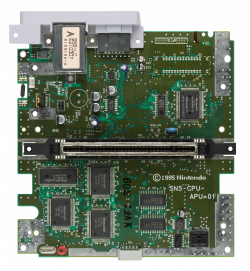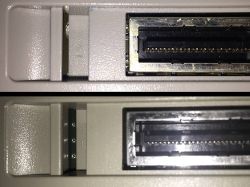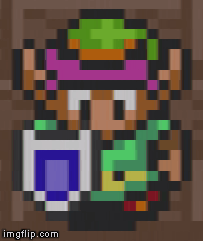SNES Model Differences
Some page content & researching collaboratively taken from io55.net's SNES page with permission.
There are two SNES models, and a variety of revisions within these models.
While there is only one board revision of the SNES Mini, the original Super Nintendo / Super Famicom consoles had many different motherboard revisions and chip changes. Most of the original SNES revisions used two video chips to produce a video signal and a CPU for general purpose processing, whereas the newer 1CHIP designated versions combine the two video Chips and the CPU on a single IC.
In 1995, Nintendo released a revision to their Super Nintendo consoles that combined the system's two video chips and the CPU into one chip labeled the S-CPUN. They appropriately labeled these motherboard revisions "1CHIP". Three total revisions were manufactured, the SNS-CPU-1CHIP-01, SNS-CPU-1CHIP-02 and SNS-CPU-1CHIP-03. The SNES Mini / SNES Jr uses the same S-CPUN chip and produces an equal or better picture as the 1CHIP models, with the exception of some minor issues with certain games.
From the official designation "1CHIP" of the later PCB revisions, the name "3-Chip" was derived due to the fact that the CPU, PPU1, and PPU2 are still on separate ICs.
Models + Revisions
Models are arranged chronologically. Revisions are underneath their respective model.
Super Nintendo Entertainment System ie. SNS-001/SHVC-001 (1990-1997)
The model of the SNES that is generally associated with the system, possessing the "classic" blocky form factor and horizontal purple slide-up buttons. The grey area in between the two purple buttons is a cartridge eject button. These consoles are common, and have the superior functionality, as long as you get a 1CHIP (later era 001s), which have much better video output. On the bottom is the smallish EXT port, mostly unused in North America, but used in Japan for the Satellaview peripheral. To the back, is the first usage of Nintendo's proprietary AV Multi Out port, plus RF output and DC in.
Distinguishing 001 revisions can be quite difficult w/o disassembly, except for distinguishing between a 3-Chip and a 1CHIP.
SHVC-CPU-01 (1990-1992)
A board revision that doesn't have good long-term prospects. These have slightly better video quality than most 3CHIP systems but are prone to CPU/PPU faults and malfunctions, at a rate which is worsening over time. SHVC boards are very easily distinguished by their larger size and a separate module which contains the sound hardware. Consoles with these boards also have four rubber feet on the bottom case.
SNS-CPU-GPM-01/02 (1992-1994)
These revisions generally do not have the CPU faults found in the SHVC boards, but have slightly worse video output. These differ from the SHVC-CPU-01 in that the sound hardware is now included on the motherboard instead of being on a separate module.
SNS-CPU-RGB-01/02 (1994-1995)
Mostly identical to the GPM revisions, but the cartridge port is now soldered to the motherboard instead of being removable as on earlier boards. The most significant change is a new video encoder chip, which now amplifies the RGB signals instead of them going through a discrete amplifier circuit.
SNS-CPU-APU-01 (1995)
The final 3-Chip revision which now has most of the sound hardware consolidated to a single chip, the S-APU. Unfortunately, these have the worst RGB video quality which is caused by a poorly routed color subcarrier trace. Severing or rewiring the subcarrier trace tends to solve this issue, though severing it also means losing color via composite and the chroma signal. It appears that some of the first UN30 serial numbers were assigned to these revisions, but these are usually associated with 1CHIP revisions.
“SNS-CPU-1CHIP-01/02/03” (1995-1997)
A generally desired revision of the SNES due to its superior video quality and still retaining all hardware features from previous revisions. The name "1CHIP" comes from the fact that all three major chips (CPU, PPU1 and PPU2) have been combined into a single ASIC known as the S-CPUN. These consoles do output slightly bright video with “ghosting”, but these issues are easily fixed. Guaranteeing if a console is a 1CHIP requires opening it and looking on the motherboard for the term 1CHIP. However, one can read the serial number to increase one’s chances, as it appears that every US 1CHIP has a serial beginning with UN3. However, not every UN3 is a 1CHIP. Some believe that UN31 is the number where 1CHIPs were introduced, but as seen below in the references, some APU-01s can have a serial starting with UN31.
1CHIP-01 and -02 revisions appear to be largely identical, but the -03 revision does not have the components for the composite sync signal populated. This may be an issue for those who use RGB cables which use the sync signal on pin 3 instead of composite video for sync. However, composite sync can be restored on the -03 by adding back in the necessary components.
On PAL units, you can look through the bottom expansion port and visually see if it's a 1CHIP as shown in the image to the right.
SNSP-001 (1992-1997)
SNSP-CPU-01/02 (1992-1995)
SNSP-CPU-1CHIP-01/02 (1995-1997)
New-Style SNES and Super Famicom Jr. ie. SNS-101/SHVC-101 (1997-2003)
Despite being a lower cost revision, not many units of the New-Style SNES were sold or made due to the increasing popularity of newer consoles such as the Nintendo 64 and PlayStation. It was also released in Japan as the Super Famicom Jr. in 1998 and was made available until 2003. These models are smaller, rounder, and have a circular reset button with a circular power switch (both colored purple in North America and gray in Japan). However, the Multi Out port does not support S-Video or crucially, RGB. There is also no RF out (though the Nintendo 64 RF modulator is compatible), no eject button or an EXT port on the bottom for Satellaview support. However, like the 1CHIP consoles, these systems have better video quality than most SNS-001s and can be easily modded to restore S-video and RGB output.
Counterfeit New-Style SNES
Counterfeit SNS-101 consoles were produced from the late 1990s up until the early 2000s. They are rare, but if you're worried about buying a clone, check out this page to make sure you have a real Nintendo-made system.
Comparisons
3-Chip vs. Mini
3-Chip vs. 1CHIP vs. Mini
1CHIP vs. Mini
References
https://www.retrorgb.com/1chipsnes.html
https://www.retrorgb.com/snes1chip.html
https://www.retrorgb.com/1chipghosting.html
https://www.retrorgb.com/snesversioncompare.html
https://console5.com/techwiki/index.php?title=SNES
https://en.wikipedia.org/wiki/New-Style_Super_NES
https://gametrog.com/super-nintendo-snes-information-specs/
https://en.wikipedia.org/wiki/Super_Nintendo_Entertainment_System (CPU bug info)
https://ancientelectronics.wordpress.com/2014/08/19/the-best-version-of-super-nintendo/





